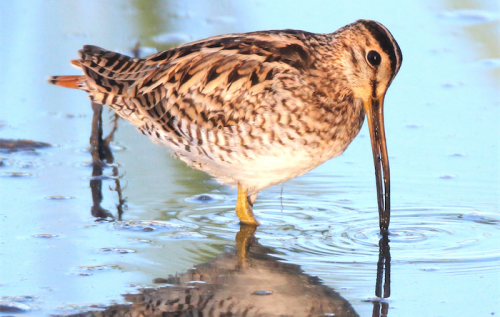
WHETHER it’s marvelling at the epic breeding journey of the Latham’s snipe or the joy of capturing a photograph of a letter-winged kite, author and ornithologist Neil Hermes says bird watching first became a passion for him while at Hughes primary school in the early 1960s.
Neil has written “A Photographic Field Guide to the Birds of the Australian High Country”, a comprehensive guide for beginners and experts, and says he’s never forgotten the moment that sparked his lifelong passion for ornithology.

“For me it was a book in the library at primary school, which I borrowed several times, and on one particular day I was able to identify a bird from the book and link it to a bird in the wild by myself with no encouragement,” he says.
“And that was the moment which drove my hobbies, my studies at school and at uni, and then my work, and I feel lucky to have had that passion for so long and so consistently. I went straight into my first job with the NSW parks service as an ornithologist in 1978.”
Neil says the book covers the 322 bird species of the high country, including all common, rare and vagrant species, distribution maps, information on topography, climate, types of habitat and key birdwatching sites.
“The Canberra bird list is about 290 species, and the book covers the high country, plus about 20 or 30,” he says.
“More than likely those will be the rare birds that will turn up in Canberra itself over the next few years, and therefore the book has also captured everything that is likely to be seen in the future as well.”
He says the book will make birdwatching easier and more accessible, and that with so many wonderful images from a variety of enthusiastic local photographers around Canberra, so much more information is provided.
“Canberra is a bird city, we love birds here, and so if you can get a fully comprehensive book that only has the birds from this area, and it doesn’t have some rare birds from South America, then you know it can only be one of these three and you can then more easily find what it is,” he says.
“I felt it was time for a book that made things more straightforward and at this point in time it’s finally possible to do a book like this with photos.
“We’re able to capture more clearly the distinct differences between male and female birds and how they appear while in flight.
“There was a similar book created with drawings in 1969 that revolutionised bird watching in Canberra, but that’s been out of print for decades and the pictures weren’t as accessible.”
Currently president of the Canberra Ornithologists Group, Neil studied science at ANU, has worked at the Australian National Parks and Wildlife Service in Kakadu and Uluru National Parks, as government conservator on Norfolk Island, at the ACT Parks and Conservation Service and Questacon.
He’s also become fascinated with the Latham’s snipe, which migrates every year from the Japanese island of Hokkaido to SA.
“It’s a remarkable journey, because they will only nest in Hokkaido and when the time comes to move on they fly directly to Papua New Guinea without stopping. One of their stopovers is the artificial habitat of Jerrabomberra Wetlands in Canberra.”
Neil says he enjoys birdwatching because birds so accessible, colourful, easy to see and hear, combined with the challenge of identifying different species.
“You see birds everywhere you go, whereas you’re not going to see a frog or a reptile so readily – structurally bird watching makes sense,” he says.
“But there’s that hunting instinct, and locating something you’ve been seeking for a long time is very powerful. There’s a combination of things that drive us to collect, to be a train spotter or a stamp collector or whatever it is. There’s that sense of hunting something down, finding it and having the conquest. There’s commonalities in all those things.”

For Neil, it was a much longed-for sighting of a letter-winged kite, a rare inland species that had been an elusive bird he’d wanted to see for 50 years.
“I decided to seek it out and camped late last year at the Strzelecki Track in the northern SA desert and finally saw the kite, and was even able to take a photograph that appears on page 75 of the book,” he says.
“A Photographic Field Guide to the Birds of the Australian High Country”, $45 from all major bookstores. Neil Hermes will sign copies at Dymocks Canberra Centre on Saturday, December 2 at 11am. The book launch will be held at Jerrabomberra Wetlands Centre, Dairy Flat Road, Friday, December 1 at 9.30am, with copies of the book available for $38. Proceeds of the day go to the Latham’s Snipe Project.
Who can be trusted?
In a world of spin and confusion, there’s never been a more important time to support independent journalism in Canberra.
If you trust our work online and want to enforce the power of independent voices, I invite you to make a small contribution.
Every dollar of support is invested back into our journalism to help keep citynews.com.au strong and free.
Thank you,
Ian Meikle, editor








Leave a Reply